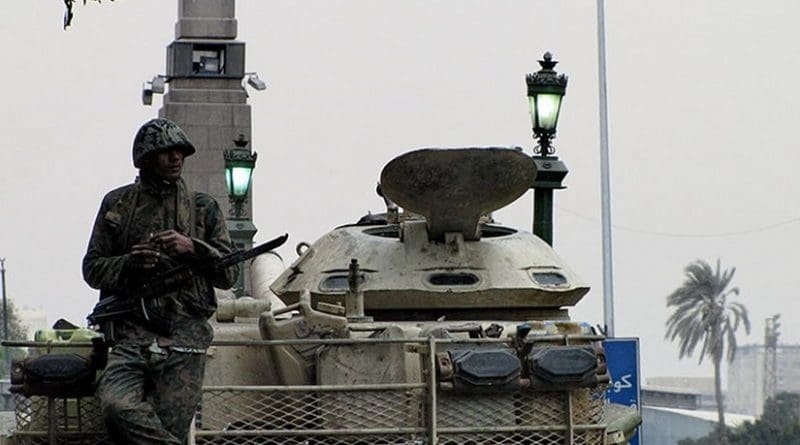Egypt’s Day After – OPED
By Arab News
By Osama Al Sharif
It’s the day after 11 February, when millions of Egyptians forced beleaguered President Hosni Mubarak to quit after a 30-year rule. This could be the sequel to the revolution; its long-awaited day after. But this time the stakes may prove to be higher for everybody.
It was perhaps inevitable that Egyptians from all walks of life emerged in tens of thousands to protest against the country’s military rulers, the Supreme Council of the Armed Forces (SCAF), who have been running Egypt for more than nine months now. The days when millions of Egyptians at Tahrir Square and other locations embraced the military while chanting “The People and the Army are One Hand” are now over.
Instead thousands of protesters have called for the resignation of the government and SACF’s top man Field Marshall Hussein Tantawi. By early this week scuffles broke out between anti-riot police and army units, on one hand, and protesters gathering at Tahrir Square, symbol of Egypt’s popular revolution, on the other. At least 30 people were killed and thousands were injured. Egypt’s political parties and movements, including the Muslim Brotherhood and the Salafis, joined the protests and called on the army to rescind a document that sets constitutional benchmarks which were seen as bolstering the military’s future role while providing it with impunity.
Political figures warned of a conspiracy aimed at hijacking the revolution, while youth and leftist movements expressed fears that the country would soon be run by religious zealots who do not believe in a civil state with secular foundations.
In fact critics of the Islamist movement say that the Muslim Brotherhood’s recent fallout with SCAF was over this specific issue and not the army’s future role and its privileges. Until last Friday’s rally the Muslim Brotherhood and its political arm, Freedom and Justice Party, had shied away from Tahrir Square demonstrations, preferring to focus on organizing their cadres and preparing for elections, the first in many, slated to be held at the end of the month.
The current showdown is the worst since demonstrators celebrated victory by toppling President Mubarak. But suspicions over the future role of the army grew almost immediately. Egypt has been run by the military, although indirectly, since the 1952 coup which overthrew the monarchy. Two of the three presidents that ruled Egypt hailed from the armed forces. Almost all of the country’s governors were retired generals.
The army’s financial and administrative affairs were never subject to legislative or civilian control. In the aftermath of the revolution, SCAF wanted to chart a new understanding under which it could maintain its independence in exchange for guaranteeing the civil nature of the state; something along the Turkish model. The Constitutional Document was supposed to pave the way for such a route.
But now the army is backing off. Tuesday’s mass protests have proved that a second revolution could easily erupt if the military rulers continue with their plan or attempt to derail elections. The controversial document has been suspended but not withdrawn, and the government of Essam Sharaf has resigned. So far elections will be held on time on 28 November, but the youth movements are demanding that the army hands over powers to a civilian authority no later than next April.
The problem with Egypt’s revolution is that while it succeeded in decapitating the system, it stopped short of replacing it. The armed forces represent the old guard in terms of the alliances that had flourished over the past 30 years between influential politicians and top army brass. And unlike Tunisia, where an enlightened Islamist movement had quickly moved to build alliances with secular parties in order to secure a peaceful and orderly transition into a civil state, Egypt’s Salafis, an emerging power, and the Muslim Brotherhood believe they can decide the future of the country on their own by exploiting their big gains at the ballot box. Leftist and secular parties and movements have no place to express their fears except at Tahrir Square and other locations across the country.
It is a messy scene because each party in the current standoff has an exclusive perception of where the country should go from here. Leftist parties point the finger at the Muslim Brotherhood for violating a previous agreement by a coalition of democratic parties which underscored the civilian character of the state, as opposed to a religious one.
By Tuesday night it appeared that SCAF was ready to make some concessions. Tantawi made a speech in which he assured Egyptians that the military had no intentions to usurp power and was ready to hand over authority as soon as presidential elections are held next year. But he stopped short of naming a new prime minister to head a national salvation government. It was important to note that Tuesday’s rallies were boycotted by the Muslim Brotherhood. The youth movements were again able to inspire and motivate. At Tahrir Square the demonstrations continued underscoring the fact that Egyptians wanted much more than what the military was willing to offer.
— Osama Al Sharif is a journalist and political commentator based in Amman.

